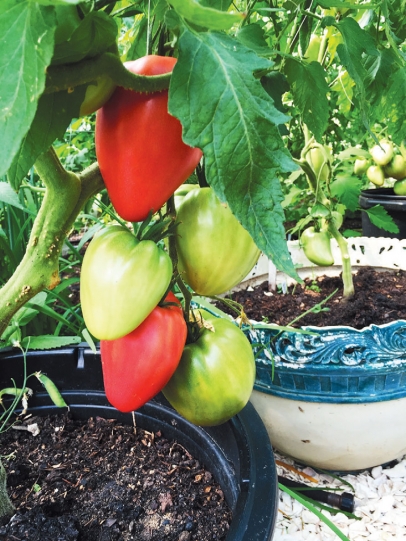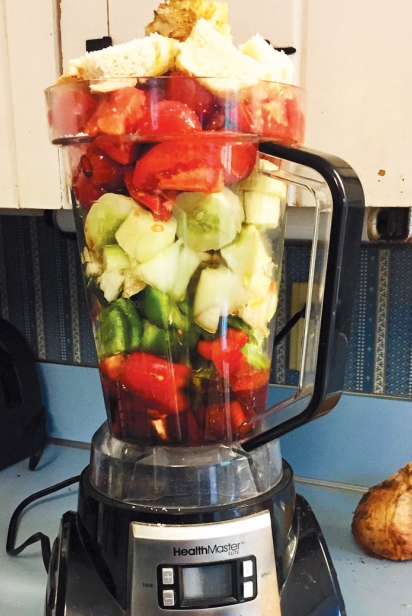Farmgirl Confidential Gazpacho – The Ultimate Tomato Destination
Before the dawn of the sustainable “food revolution” in America in the early 1970s, TV dinners were still the rage and, “being a chef was like being a plumber,” according to writer Jerry Weinberger in the pages of America’s Food Revolution magazine. There was little demand by chefs or their patrons for local produce. Produce associated with large-scale commercial agriculture was the standard. The home gardener or market farmer was not even privy to the incredible numbers of vegetable varieties that existed in the world.
Each year the same plant varieties were offered for sale at local nurseries and promoted as staples for success. Seed catalogs were no different. Year after year spring gardeners rushed to garden centers to get their Betterboy, Beefsteak or Big Girl tomato starts. As the food revolution swept across the country, pioneering chefs soon became rock stars. They demanded outstanding flavor from freshly-picked local, unique produce that added visual excitement and taste to their presentations. Market growers searched for exciting new vegetables to quell the thirst of innovative entrepreneurs like Alice Waters, with her opening of Chez Panisse in Berkeley, California in 1971. The search led growers straight into the world of heirloom varieties. The seed sellers stepped up to the plate and a plethora of interesting and unusual vegetables appeared.
Growing heirlooms quickly became an obsession for many: a “cause” and even a movement. The reasons for their popularity are as diverse as the heirlooms themselves, with taste being the driving force. Growing heirloom vegetables and saving their seeds preserves and enhances sustainability and biodiversity. It also promotes condition-specific, disease-resistant vegetables that might otherwise be lost to the harsh economics of seed marketing and the even harsher practices of industrial agriculture.
I became so excited about the limitless variety of these heirlooms from the start, particularly artisan tomatoes, that I ordered a vast selection of the most unusual ones that I could find. I was quick to learn that not many of these oddly-shaped, colorful tomatoes would immediately thrive out of their original gardens. They slowly withered away from disease or environmental stress. Their original hardiness, disease and pest resistance (developed over many years) would take a few years and several generations of seed collecting to acclimate to their new environment here on Cape Cod. One advantage they had going for them was their ability to eventually adapt to both climate and soil conditions. This is unlike modern hybrids, which are bred to grow in a wide variety of conditions, sacrificing flavor during the process.
My first year of growing heirloom, artisan tomatoes did not go so well. Some didn’t even make it past the potting stage. Frail, spindly and wispy seedlings were so weak that I just cast them out the back door of the greenhouse. A few succeeded and grew to maturity but none really lived up to my expectations as promised in the catalogs. That is, except one.
One day in mid-summer while walking down an overgrown path behind my greenhouse, my eye caught something bright and colorful partially hidden under a bush. I pushed the bush aside and couldn’t believe what I saw. It was a massive, reddish-pink, heart-shaped tomato on a spindly, prostrate vine. It was unbelievable and so improbable that it could have grown from such a wispy, fern-like plant. It was still in its overturned pot and now rooted in the ground, one of those weak seedlings that I had thrown out the back door. No other tomatoes in the garden had yet produced that season, except for this castaway. Its tag was still attached, and I discovered that it was an Oxheart tomato. I had never grown one before and it turned out to be the most delicious tomato I had ever tasted. I saved the seed from that amazing tomato and have been planting it every year with wild anticipation of its ultimate destination.
What is an Oxheart? It is often described as fragrant, strawberry-shaped and beefsteak-like, yet even larger. This oxheart shape, I learned, is the result of a mutation believed to have taken place around 1925. Oxhearts are immense and as juicy as a watermelon and just as sweet. Their heavy-yielding vines produce extra-large fruits weighing 1-2 pounds each. They have firm, meaty flesh with very few seeds. The Oxheart isn’t a single variety but rather a group of varieties with common characteristics, and many are almost acid-free. They are most often pinkish, but some varieties are tomato-red, orange, or yellow. Some are said to produce rather late in the season, but most are very early. The orange heart is the only late-producer that I have found.
After years of trying every unusual heirloom tomato variety that I could find, I now grow (almost exclusively) Oxheart tomatoes. I can barely find a reason to grow any other type. I have two that I grow in great abundance, Italian Heirloom and Wolford’s Wonder, but I always leave room in the garden to try a few new Oxheart varieties.
I have chosen to grow on single stems this year, pinching off all suckers and removing all leaves below flower clusters once tomatoes begin to form. Oxhearts’ naturally spindly form lends itself to this method. These single-stem leaders are attached to a pulley and string system connected to an overhead wire. This way I can grow my plants 12” apart allowing many more plants in a small space. As the plant grows taller the string on the pulley is released a few feet, and the pulley is then moved down the wire, allowing the tomato free room to grow at a horizontal angle. One advantage of this method is that only large healthy tomato clusters are growing directly off the main stem and the removal of unnecessary leaves sends more energy into the tomatoes themselves.
I make two plantings a year, one in March and again in mid- to late June because they flower and produce so quickly. By having a fresh crop in late summer, I can avoid the curse of the northeast, late blight. The disease that was responsible for the Irish potato famine in the nineteenth century, late blight causes crinkling leaves, blackened fruit and overall failure of the crop in tomatoes. Read up on the late blight pandemic of the northeast and how it began in 2009 and you may never buy a tomato seeding from a box store again.
I can never pass a summer without growing these extraordinary tomatoes. I grow them for my most anticipated late summer garden treat, the ultimate tomato destination: gazpacho. Gazpacho is made from uncomplicated ingredients that are easily found in the late summer garden. It’s one of those simple and perfect culinary experiences in which the whole is much greater than the sum of its parts. Simple perhaps, but masterfully calculated through a secret subtlety of proportions preferred by each maker and chef.
Gazpacho is characterized today as a cold soup predominantly featuring tomatoes with sweet peppers, cucumbers, garlic and other fresh garden veggies. It is most often associated with Spanish cuisine, especially that of Andalusia, but its beginnings actually predate the 16th century arrival of many of its ingredients in Europe, and dates back to at least the 7th century where it all started with stale bread.
In those early days, garlic, salt and bread were pounded in a mortar-like vessel and then vinegar and olive oil were added. Roman Empire soldiers would carry pieces of stale bread, garlic, and olive oil with them on their journeys. Hints of Roman culinary tradition also appear in the evolution of gazpacho. The use of vinegar in gazpachos refers to the Roman addition of vinegar to food for refreshment during warm weather. It also carries influences from the Moors and Arab culture with the use of cumin in the mix.
As the story goes, it wasn’t until Columbus sailed into Seville with a boatload of “New World” tomatoes and peppers that gazpacho became what we know it as today. Well, as it turns out, it’s not Columbus, but Cortes in 1521 who introduced the Peruvian tomato to Spain. At any rate, gazpacho was a dish that faced no social or class barriers and has graced the tables of both the upper and lower classes of societies worldwide. Centuries ago field workers were given a ration of bread and oil and would add other ingredients from the field. The wealthy, meanwhile, considered it a refreshing treat. On any given late summer day, it was found on the tables of great estates, served as a thirst quenching, nutritious meal.
Gazpacho is an extremely easy delicacy to whip up in a blender in just a matter of minutes but demands only the ripest tomatoes and freshly-picked veggies. Many chefs insist that the tomatoes should always go through a sieve so there are no seeds in the finished dish. Since Oxheart tomatoes have very few seeds, it’s just another reason that they make the perfect choice.








